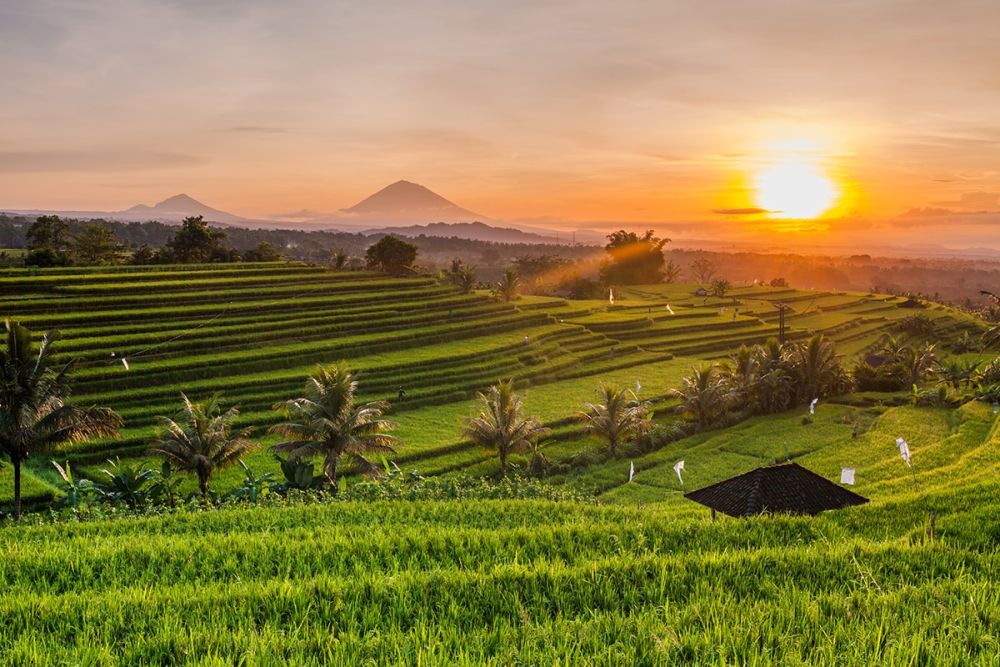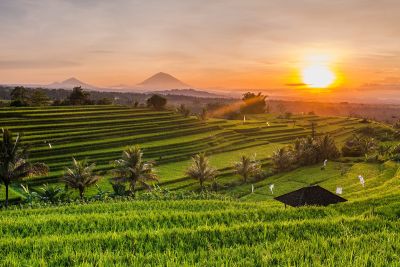

Embark on a tropical journey through the Sacred Monkey Forest Sanctuary, a protected reserve and a temple complex in Ubud. This natural habitat is home to a horde of grey long-tailed macaques who roam freely amongst the ancient temples. As you stroll along the peaceful pathways, lined with moss-laden statues and towering trees, a sense of tranquility and connection to nature prevails. The sanctuary aims to conserve the area based on the concept of Tri Hita Karana, which promotes the harmonious relationship between humans, nature, and the spiritual realm. While there, observe the monkeys in their natural behavior, but be cautious with your belongings as they are known to be quite cheeky. The visit is also an exceptional opportunity to capture photographs of the intricate carvings and stone designs that adorn the forest.
A vibrant tapestry of colors, sounds, and smells welcomes you as you enter the Ubud Traditional Art Market, locally referred to as 'Pasar Seni Ubud'. Located opposite the Puri Saren Royal Ubud Palace, this market is a bustling hub of culture, where local artisans showcase their handiwork. It is a place where you can admire and purchase a variety of crafts, textiles, paintings, and handmade souvenirs peculiar to Balinese culture. Negotiating prices is expected and part of the fun. The market is split into two sections: one for souvenirs geared towards tourists, and another for everyday household items and groceries for locals. An early morning visit ensures you beat the crowds and catch the market at its liveliest, as this is when fresh produce arrives. Enjoy this immersive shopping experience and take a little piece of Bali home with you.
The Tegalalang Rice Terrace, located north of Ubud, offers one of the most iconic views of Bali. This scenic point is a series of rice paddies set on cliffs, employing a traditional Balinese cooperative irrigation system known as 'subak'. A visit to the rice terraces is a must for anyone seeking to experience the beauty and agricultural tradition of the region. As you traverse the slopes around the valley, the lush and layered landscape provides a wonderful photography backdrop and a chance for physical activity. Local farmers often offer tours and insights into the cultivation process, giving visitors a deeper appreciation of the complexity and labor involved in rice farming. Cafes and shops perched on the edge of the terrace provide spots to relax and absorb the green vistas, making it an ideal outing for nature lovers and culture enthusiasts alike.
The Campuhan Ridge Walk is a free and easy nature trek, popular among locals and visitors alike. This picturesque walk offers an escape from the bustle of the town's center into the greenery of Ubud's hills. The path provides stunning vistas of the surrounding valleys, with verdant rice fields and palm trees that mark the Balinese landscape. The walk starts near the Warwick Ibah Luxury Villas and Spa, following the crest of the hill on a paved pathway. The best times to embark on this walk are early morning or late afternoon when the temperature is cooler, and the light casts a magical glow on the scenery. The trail is approximately 9 kilometers round-trip, and along the way you may encounter charming art galleries, quaint cafes, and local artisans. Remember to bring a hat and water for the trek as it can get quite warm during the day.
The Kecak Fire Dance is a remarkable show that conveys a tale from the Hindu epic, the Ramayana, through captivating dance and music. Performed regularly at Pura Dalem Taman Kaja in Ubud, the display combines chanting, elaborate costumes, and powerful dance movements to tell the story of Prince Rama, his wife Sita, and the monkey god Hanuman. This dance-drama is unique as it has no musical instruments; instead, a troupe of men provide the 'cak-cak-cak' chorus rhythmically, creating a hypnotic and dynamic audio backdrop to the performance. As the sun sets, the dance culminates in a dramatic fire-walking performance symbolizing the battle between good and evil. The fire dance is a cultural highlight that allows spectators to glimpse into the rich traditions and artistic expressions of Ubud.
For the adventurous spirits, White Water Rafting on the Ayung River offers an exhilarating and wet thrill ride through the heart of Bali's breathtaking landscapes. Suit up and follow experienced guides on a river journey that combines moments of calm with rolling rapids through canyons, waterfalls, and lush rainforests. The Ayung River is Bali's longest river and provides a moderate but exciting rafting course, suitable for beginners and experienced rafters. During breaks in the action, there’s time to admire the intricate carvings along the riverbanks and plunge into the refreshing waters for a swim. Available for half a day, this adventure often includes transport to and from Ubud, all necessary equipment, and sometimes lunch. It’s an unforgettable way to connect with nature and experience Bali’s natural beauty up close.
Indulge in a gastronomic journey by joining a Balinese Cooking Class, where you'll learn the secrets of traditional Balinese cuisine. These classes typically begin with a visit to the local market to gather fresh ingredients, offering insights into Ubud's culinary culture. Under the guidance of friendly and experienced chefs, you'll be introduced to exotic spices and a variety of organic ingredients that flavor the local dishes. Hands-on experience will have you grinding pastes, marinating proteins, and wrapping delicate parcels for steaming. Cooking classes offer a series of recipes, including some for vegetarian options, which participants can recreate back home to relive their Bali experience. The class ends with the rewarding experience of enjoying a homemade Balinese feast that you've helped to prepare.
Ubud Palace, or Puri Saren Agung, is the historical seat of the Ubud Royal family and a focal point of cultural significance and architectural beauty in the area. The palace, with its ornate carvings and spacious courtyards, serves as a magnificent example of traditional Balinese palace architecture. It stands at the center of Ubud, and part of it remains a royal residence, while the rest of the grounds are open to the public. The compound's well-preserved structures and the charming ambiance reflect the richness of the island's history and royal past. In the evenings, the palace comes to life with cultural performances such as Balinese dance and music shows. Walking through Puri Saren Agung provides an intimate look into the royal heritage that contributes to the strong cultural identity of Ubud and Bali as a whole.
For those seeking an adrenaline rush paired with stunning views, the Bali Swing has become an iconic experience near Ubud. Here you will find numerous swings of varying heights that let you soar over lush jungorous landscapes and the valley below. Some swings reach up to 78 meters in height, providing exhilarating sensations and incredible photo opportunities. Besides the famous swings, the site often offers additional picture-perfect spots like nests, hearts, and rocks standing on the edge above the valley or river. Safety is a top priority, with harnesses and professional staff on hand to ensure a secure adventure. The Bali Swing experience is more than just swinging; it’s about capturing the moment of freedom and joy against the backdrop of Bali’s natural splendor. The activity typically includes pickup and drop-off from Ubud, lunch, and unlimited time on the swings.
The Agung Rai Museum of Art (ARMA) is more than just an art museum; it is a center for visual and performing arts that allows visitors to dive deep into the world of Balinese culture. Founded by Agung Rai as a cultural repository, this museum houses a large collection of works by well-known Balinese artists, as well as international artists who made Bali their home, such as Walter Spies and Rudolf Bonnet. You can explore traditional to contemporary pieces, and artworks that have shaped the island's artistic heritage. Set within lush tropical gardens, ponds, and fountains, ARMA also serves as an educational resource with art classes, workshops, and cultural performances. Visiting this museum offers a peaceful cultural retreat and a chance to appreciate the island's artistic endeavors, both old and new.
